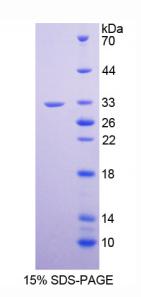巢蛋白(NID)重组蛋白
产品名称: 巢蛋白(NID)重组蛋白
英文名称: Recombinant Nidogen (NID)
产品编号: YB466Hu011
产品价格: 0
产品产地: 中国/美国
品牌商标: 钰博生物/Ybscience
更新时间: 2023-08-17T10:29:50
使用范围: null
- 联系人 : 陈环环
- 地址 : 上海市沪闵路6088号龙之梦大厦8楼806室
- 邮编 : 200612
- 所在区域 : 上海
- 电话 : 183****2235
- 传真 : 021-60514606
- 邮箱 : shybio@126.com
巢蛋白(NID)重组蛋白
YB466Hu011
Recombinant Nidogen (NID)
Organism Species: Homo sapiens (Human)
Instruction manual
FOR IN VITRO USE AND RESEARCH USE ONLY
NOT FOR USE IN CLINICAL DIAGNOSTIC PROCEDURES
10th Edition (Revised in Jan, 2014)
巢蛋白(NID)重组蛋白[ PROPERTIES ]
Residues: Ala971~Cys1219
Tags: Two N-terminal Tags, His-tag and T7-tag
Accession: P14543
Host: E. coli
Subcellular Location: Secreted, extracellular
space, extracellular matrix, basement membrane.
Purity: >90%
Endotoxin Level: <1.0EU per 1μg
(determined by the LAL method).
巢蛋白(NID)重组蛋白Formulation: Supplied as lyophilized form in 100mM
NaHCO3, 500mM NaCl, pH8.3, containing 1mM EDTA,
1mM DTT, 0.01% sarcosyl, 5% trehalose, and
preservative.
Predicted isoelectric point: 6.3
Predicted Molecular Mass: 31.6kDa
Applications: SDS-PAGE; WB; ELISA; IP.
(May be suitable for use in other assays to be determined by the end user.)
[ USAGE ]
Reconstitute in sterile ddH2O.
[ STORAGE AND STABILITY ]
Storage: Avoid repeated freeze/thaw cycles.
Store at 2-8oC for one month.
Aliquot and store at -80oC for 12 months.
Stability Test: The thermal stability is described by the loss rate of the target
protein. The loss rate was determined by accelerated thermal degradation test,
that is, incubate the protein at 37oC for 48h, and no obvious degradation and
precipitation were observed. (Referring from China Biological Products Standard,
which was calculated by the Arrhenius equation.) The loss of this protein is less
than 5% within the expiration date under appropriate storage condition.
[ SEQUENCES ]
The sequence of the target protein is listed below.
巢蛋白(NID)重组蛋白AFLHVPAKVI IGLAFDCVDK MVYWTDITEP SIGRASLHGG EPTTIIRQDL GSPEGIAVDH
LGRNIFWTDS NLDRIEVAKL DGTQRRVLFE TDLVNPRGIV TDSVRGNLYW TDWNRDNPKI
ETSYMDGTNR RILVQDDLGL PNGLTFDAFS SQLCWVDAGT NRAECLNPSQ PSRRKALEGL
QYPFAVTSYG KNLYFTDWKM NSVVALDLAI SKETDAFQPH KQTRLYGITT ALSQCPQGHN
YCSVNNGGC
[ REFERENCES ]
1. Nagayoshi T., et al. (1989) DNA 8:581-594. 2. Zimmermann K., et al. (1995) Genomics 27:245-250. 3. Fazio M.J., et al. (1991) J. Invest. Dermatol. 97:281-285. 4. Bian Y., et al. (2014) J. Proteomics 96:253-262.
